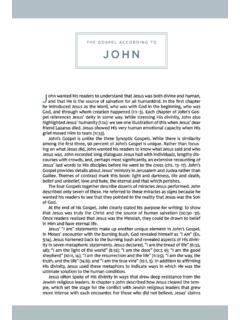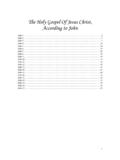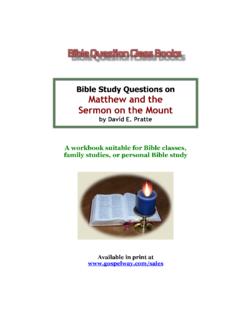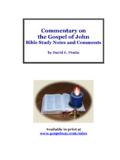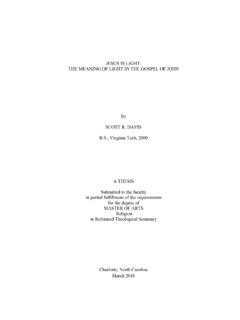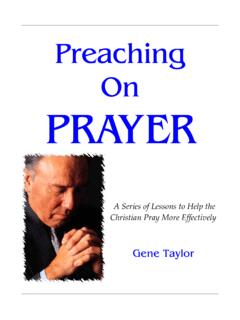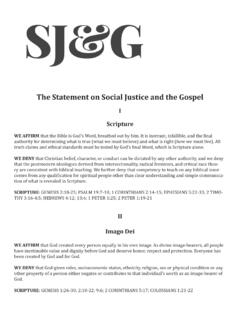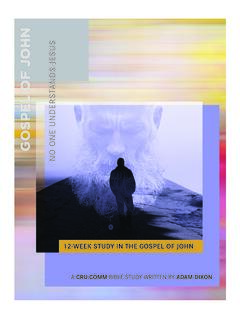Transcription of THE STRUCTURE OF THE GOSPEL OF MATTHEW AS …
1 Tyndale Bulletin 34 (1983) 61-70. THE TYNDALE NEW TESTAMENT LECTURE, 1982 THE STRUCTURE OF THE GOSPEL OF MATTHEW AS NARRATIVE* By H. J. Bernard Combrink I PROBLEM Concerning the STRUCTURE - or composition - of the GOSPEL of MATTHEW , no consensus has thus far been reached among New Testament scholars. This is actually quite surprising in the light of the great number of redaction-critical studies devoted to the GOSPEL of MATTHEW in recent But perhaps it is really not so surprising, since the tension, between tradition and redaction, so important for redaction- critics, very often leads to an emphasizing of the additions and changes in the redactional sections of a GOSPEL .
2 Without really coming to grips with the problem of the composition as a Research in recent years has also underlined that there are various structural features in MATTHEW which can be utilized in determining the composition of this GOSPEL . Recently D. O. Via again drew attention to two of the most obvious competing structures in MATTHEW , viz. the well-known five-fold formula (7:28; 11:1; 13:53; 19:1; 26:1), and the repetition of the phrase in 4:17 * Research for this paper was made possible by a grant from the Human Sciences Research Council of South Africa.
3 The guidance and advice of Roland M. Frye, Felix E. Schelling Professor of English Literature at the University of Pennsylvania, is gratefully acknowledged. 1. Cf. S. P. Keally, 'The Modern Approach to MATTHEW ', Biblical Theology Bulletin 9 (1979) 165-178. 2. R. C. Tannehill, 'The Disciples in Mark: The Function of a Narrative Role', JR 57 (1977) 386-387. 62 TYNDALE BULLETIN 34 (1983) and 16 The first scheme remains to this day the basis for many varying outlines of MATTHEW based on the five discourses of Jesus and alternative narrative sections, with a strong emphasis on such matters as the law, the five books of Moses, and Jesus as the new The second scheme divides the GOSPEL into three sections dealing with: (1) the person of Jesus Messiah (1:1 - 4:16); (2) the proclamation of Jesus Messiah (4:17 - 16:20); (3) the suffering, death and resurrection of Jesus Messiah (16:21 - 28:20).
4 5 Various other principles for analysing the STRUCTURE of MATTHEW have been proposed. according to some MATTHEW followed Mark's geographical outline. This implies that - 18:35 deals with Jesus' public ministry in Galilee; 19:1 - 20:34, from Galilee to Jerusalem; 21:1 - 27:66, the last week in and near Jerusalem; and 28:1-20, the resurrection and appearances of the F. W. Beare, however, maintains that the changes by MATTHEW in Markan order are pedagogical and literary, not Various topical outlines have also been proposed - , on based on the metaphors of Father and Son: (1) Father and Son: establishing the metaphor (1:1 - 12:50); (2) Father and Son: exploring the metaphor (13:1 - 27:66); (3) Father and Son: transcending the metaphor (28:1-20).
5 8 Some scholars detect a symmetrical or concentric pattern in the composition of MATTHEW , although there are also differences of opinion amongst them. according to H. B. 3. O. Via, ' STRUCTURE , Christology, and Ethics in MATTHEW ', in R. A. Spencer (ed.), Orientation by Disorientation: Studies in Literary Criticism and Biblical Criticism Presented in Honor of William A. Beardslee (Pittsburgh: Pickwick, 1980) 199-200. 4. W. Bacon, Studies in MATTHEW (New York: Holt, 1930). Cf., , J. P. Meier, The Vision of MATTHEW : Christ, Church and Morality in the First GOSPEL (New York: Paulist, 1978).
6 5. D. Kingsbury, MATTHEW : STRUCTURE , Christology, Kingdom (Philadelphia: Fortress, 1975) 25. 6. Cf. the introductory notes to MATTHEW in the TEV. 7. W. Beare, The GOSPEL according to MATTHEW : A Commentary (Oxford: Blackwell, 1981) 15. 8. O'Connor and J. Jimenez, The Images of Jesus: Exploring the Metaphors in MATTHEW 's GOSPEL (Minneapolis: Winston, 1977) 13. COMBRINK: STRUCTURE of MATTHEW as Narrative 63 Green9 chapter 11 is the central point of the symmetrical pattern, while P. F. Ellis sees chapter 13 as the centre, with the other your discourses and narrative sections arranged in symmetrical fashion around In the face of such a confusing array of proposed outlines it may be wise to take note of R.
7 C. Tannehill's remark that all the neat topical outlines may not necessarily be appropriate to a narrative and that biblical scholars ought to have a greater awareness of how stories are told and how they II THE GOSPEL OF MATTHEW AS NARRATIVE A. A Change of Paradigm The previous remark of Tannehill, as well as the title of this paper, are to be seen as indicating a shift of emphasis, or rather a change of paradigm in biblical studies. Without for one moment recommending that all historical research in relation to the Gospels should be abandoned, one has to admit that there is an awareness of a methodological crisis in historical At the same time New Testament scholars have been urged to rely more heavenly upon the best tested and most effective literary critical 9.
8 H. B. Green, 'The STRUCTURE of St MATTHEW 's GOSPEL ', in F. L. Cross (ed.), Studia Evangelica, IV. Part I: The New Testament Scriptures (Berlin: Akademie Verlag, ) 47-59. 10. P. F. Ellis, MATTHEW : His Mind and His Message (Collegeville: Liturgical, 1974) 12. Cf. C. H. Lohr, 'Oral techniques in the GOSPEL of MATTHEW ', CBQ 23 ( ) 403-435, and A. Di Marco, 'Der Chiasmus in der Bibel: 3. Teil', LingBibl 39 (1976) 11. Tannehill, 'Disciples in Mark' 387. 12. P. Stuhlmacher, 'Thesen zur Methodologie gegenw rtiger Exegese', ZNW 63 (1972) 18-26; F.
9 Hahn, 'Probleme historischer Kritik', ZNW 63 (1972) 1-17; L. E. Keck, 'Will the Historical-Critical Method Survive?' in R. A. Spencer (ed.), Orientation 115-127. 13. Cf. R. M. Frye, 'The Jesus of the Gospels: Approaches through Narrative STRUCTURE ', in D. Y. Hadidian (ed.), From Fait to Faith: Essays in Honor of Donald G. Miller (Pittsburgh Theological Monograph Series 31) (Pittsburgh: Pickwick, 1979) 75. 64 TYNDALE BULLETIN 34 (1983) his growing interest in a literary approach to the Bible covers a broad spectrum of views and In all of this a great deal of attention has been focussed on narrative.
10 A considerable amount of this work is fully developed literary structuralism. Although the various proponents of these approaches have done so much to develop narrative theory and methodology as well as to produce exegetical studies aimed at verifying and elucidating the method, D. Patte recently had to concede that 'the parousia of structural exegetical results is delayed'.15 It is therefore, significant to see that R. Alter finds the new narratology's usefulness limited. He also cautions Biblical scholars against just taking over some modern literary theory and applying it to ancient texts 'that in fact have their own dynamics, their own distinctive conventions and characteristic techniques'.
